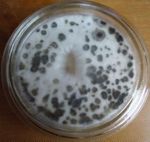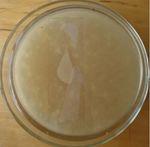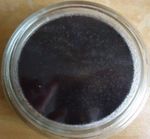Study of the Antifungal Action of the Lacquer Based on the GABA Derivative of 2-Chloro-N-(9,10-Dioxo-9,10- Dihydroanthracen-1-yl)Acetamide
←
→
Page content transcription
If your browser does not render page correctly, please read the page content below
Article
Volume 11, Issue 2, 2021, 8818 - 8824
https://doi.org/10.33263/BRIAC112.88188824
Study of the Antifungal Action of the Lacquer Based on
the GABA Derivative of 2-Chloro-N-(9,10-Dioxo-9,10-
Dihydroanthracen-1-yl)Acetamide
Maryna Stasevych 1,* , Viktor Zvarych 1 , Volodymyr Novikov 1
1
Department of Technology of Biologically Active Substances, Pharmacy and Biotechnology, Lviv Polytechnic National
University, 13, 79013 Lviv, Ukraine
* Correspondence: maryna.v.stasevych@lpnu.ua;
Scopus Author ID 8636372500
Received: 17.07.2020; Revised: 15.08.2020; Accepted: 16.08.2020; Published: 21.08.2020
Abstract: Onychomycosis is one of the most acute problems of modern medicine, which accounts for
about 50% of all nail diseases. Fungi of dermatophytes of the genus Trichophyton are the most studied
etiological factor of onychomycosis. Non-dermatophytes can also cause onychomycosis. Fungi of the
genus Aspergillus is one of the main pathogens among the non-dermatophytes agents of
onychomycosis. Antifungal nail lacquer is the most optimal dosage form for the topical treatment of
onychomycosis. GABA derivative of 2-chloro-N-(9,10-dioxo-9,10-dihydroanthracen-1-yl)acetamide
was used as a perspective antifungal agent in the form of lacquer. The antifungal action of the obtained
lacquer containing compound 2 against fungus strain Aspergillus niger VKM F-1119 was compared
with the known antifungal lacquer “Lamisil” containing terbinafine as the active agent. Investigation of
the antifungal action was carried out at concentrations of 1%, 0.5%, and 0.1% of compound 2 and
terbinafine using the diffusion in agar technic after 24 h and 72 h. It has been determined that derivative
2, as well as terbinafine at a concentration of 1%, caused fungicidal action after 24 h and fungicidal and
fungistatic effect after 72 h.
Keywords: lacquer; antifungal action; Aspergillus niger; GABA; 2-chloro-N-(9,10-dioxo-9,10-
dihydroanthracenyl)acetamide.
© 2020 by the authors. This article is an open-access article distributed under the terms and conditions of the Creative
Commons Attribution (CC BY) license (https://creativecommons.org/licenses/by/4.0/).
1. Introduction
Onychomycosis is one of the most acute problems of modern medicine, which accounts
for about 50% of all nail diseases [1-3]. Fungi of dermatophytes of the genus Trichophyton are
the most studied etiological factor of onychomycosis [4]. Non-dermatophytes - yeast and mold
fungi can also cause onychomycosis [5]. Fungi of the genus Aspergillus is one of the main
pathogens among the non-dermatophytes agents of onychomycosis [6-8].
Antifungal nail lacquer is the most optimal dosage form for the topical treatment of
onychomycosis [9]. They are devoid of some serious disadvantages (for example, the active
substance is not fixed on the nail plate for a long time; the unsightly appearance of the nail
plate when applying a cream or ointment; a long period of use of the drug, the multi-stage
process of application, etc.) compared to such dosage forms in the form ointments, creams, and
solutions [10, 11].
https://biointerfaceresearch.com/ 8818https://doi.org/10.33263/BRIAC112.88188824
The medicaments in the form of nail lacquers [12-14] are developed with
physicochemical and physiological characteristics of the nail, so they can be applied directly
to the nail plate. A protective film forms on the surface of the nail, helping to prevent the flow
of oxygen from the outside and the mycotic microorganisms spreading [15]. Also, due to this
film, the concentration of medicinal substances inside the nail remains high. Most antifungal
nail lacquers not only treat the disease but also improve the condition of the nail plates [16,
17]. It should be noted that some lacquers, which include amino acids (lysine, methionine) have
pronounced regenerative properties [18, 19]. Amino acids allow to strengthen nails, improve
its protective properties, and the ability to resist fungal infections [18, 19].
Derivatives of 9,10-anthracenedione are promising objects for the search for new
antimicrobial, including antifungal agents [20-26]. Previously [22], we had synthesized a series
of amino acid derivatives of 2-chloro-N-(9,10-dioxo-9,10-dihydroanthracen-1-yl)acetamide,
among which GABA derivative with antifungal effect against the test culture of the fungus A.
niger VKM F-1119 at a minimum inhibitory concentration of 1.9 μg/ml was selected.
Therefore, the aim of this study was to obtain the lacquer based on GABA derivative
of 2-chloro-N-(9,10-dioxo-9,10-dihydroanthracen-1-yl)acetamide and to study its antifungal
effect against the strain A. niger in comparison with the known antifungal lacquer.
2. Materials and Methods
2.1. Materials.
4-((2-((9,10-Dioxo-9,10-dihydroanthracen-1-yl)amino)-2-oxoethyl)amino)butanoic
acid 2 was obtained from 2-chloro-N-(9,10-dioxo-9,10-dihydroanthracen-1-yl)acetamide 1
according to the described method [20]. All chemicals were of reagent grade and used without
further purification. The solvents were purified according to the standard procedures [27].
Colorless nail lacquer "Nogotok" (Cosmetic-Service, Ukraine) was used as a basis for
the preparation of antifungal lacquer with compound 2. Antifungal nail lacquer "Lamisil 1%"
(manufacturer "Delpharm Uning SAS", France) was used as a reference drug.
2.2. Chemistry.
The melting points were measured on a Boetius melting point-device and are
uncorrected. 1H NMR (400 MHz) and 13C NMR (100 MHz) spectra were recorded in DMSO-
d6 solutions on a Varian Mercury-400 spectrometer with TMS as an internal standard. IR
spectra were recorded in KBr pellets on the Specord M-80 spectrometer. Mass spectra were
recorded on an Agilent 1100 Series G1956BLC/MSD SL LCMS system using electrospray
ionization at atmospheric pressure (70 eV). Elemental analysis was performed on a
PerkinElmer CHN-analyzer Series 2400. The individuality of the obtained compound was
monitored by TLC on Silufol UV-254 plates.
4-((2-((9,10-Dioxo-9,10-dihydroanthracen-1-yl)amino)-2-oxoethyl)amino)butanoic
acid 2.
Yield 73%. M.p. = 190-191 oС. 1H NMR, δ, ppm: 1.85 (m, 2H, CH2), 2.46 (m, 2H,
CH2), 3.47 (m, H, CH2), 4.11 (m, 2H, CH2), 4.61 (s, 1Н, NH), 7.86-7.79 (m, 3H, CНar), 8.31-
8.13 (m, 3H, CНar), 9.11 (d, 1H, J = 7.7 Hz, CHar), 10.72 (s, 1H, NH), 12.85 (s, 1H, OH). IR,
sm-1: 3423 (CH2NH), 3368 (NHСО), 3000-2500 (COОН), 1721 (С=О in СООН), 1685, 1627
https://biointerfaceresearch.com/ 8819https://doi.org/10.33263/BRIAC112.88188824
(С=О), 1643 (СОNH). LC-MS, m/z (Irel, %): 367 [M+1] (100%). Found, %: C 65.49; H 5.03;
N 7.71. C20H18N2O5. Calculated, %: C 65.57; H 4.95; N 7.65.
2.3. Antifungal action of the lacquer.
Antifungal effect of the lacquer based on 4-((2-((9,10-dioxo-9,10-dihydroanthracen-1-
yl)amino)-2-oxoethyl)amino)butanoic acid 2 at concentrations of 0.1%, 0.5% and 1% was
investigated by diffusion in peptone on nutrient medium (wort agar) [28]. The microbial
loading was 109 cells (spores)/cm3. The required incubation period were 48–72 h at 28–30 °C.
The results were recorded by measuring the zones surrounding the disk. Reference disk
contained «Lamisil» at concentrations of 0.1%, 0.5% and 1%. The control disk contained
lacquer without antifungal agents.
3. Results and Discussion
3.1. Chemistry.
Continuing our research on the search for new substances with practically valuable
properties among the functionalized derivatives of 9,10-anthraquinone [29-33], in work
presented herein we report a study of the antifungal action of the lacquer based on the 4-((2-
((9,10-dioxo-9,10-dihydroanthracen-1-yl)amino)-2-oxoethyl)amino)butanoic acid 2 obtained
using the method [20] (Scheme 1).
Scheme 1. Synthesis of 4-((2-((9,10-dioxo-9,10-dihydroanthracen-1-yl)amino)-2-oxoethyl)amino)butanoic acid 2.
3.2 Investigation of antifungal action.
The colorless nail lacquer «Nogotok» containing the following components: ethyl
acetate, butyl acetate, nitrocellulose, adipic acid/neopentyl glycol/trimellitic copolymer
anhydride, acetyl tributyl citrate, isopropyl alcohol was used as a basis for the preparation of
antifungal lacquer with compound 2. As a reference drug was taken terbinafine in the form of
1% nail lacquer "Lamisil". Nail lacquer without the addition of antifungal agents was used as
a control.
Lacquers with derivative 2 at concentrations of 1%, 0.5%, and 0.1% and diluted lacquer
with terbinafine "Lamisil" to concentrations of 0.5% and 0.1% were prepared for the study.
Lacquers with appropriate concentrations, a control sample of the nail lacquers "Nogotok" and
"Lamisil" were added to microscope slides, placed in Petri dishes, and covered with agarized
sterile medium under laminar conditions. Then the test culture of fungus A. niger was added,
and the dishes were cultured at 28 ± 1 ° C in the thermostat. The results of the observations
were recorded after 24 h (Figure 1) and 72 h (Figure 2).
https://biointerfaceresearch.com/ 8820https://doi.org/10.33263/BRIAC112.88188824
After 24 h incubation (Figure 1) in dishes with derivative 2 at a concentration of 0.1%,
a fungicidal effect was observed with a small number of fungal colonies compared to the
control, while terbinafine at the same concentration was slightly predominant. Compound 2 at
a concentration of 0.5% caused the same growth of the mycelium of the fungus A. niger as in
control, whereas under the action of terbinafine, the amount of mycelium was higher. Amino
acid derivative 2 at a concentration of 1% had a fungicidal effect at the same concentration of
terbinafine, whereas the control contained a lot of fungal mycelium.
control 0.1 % terbinafine 0.1 % compound 2
control 0.5 % terbinafine 0.5 % compound 2
control 1 % terbinafine 1 % compound 2
Figure 1. The influence of derivative 2 and terbinafine in the concentrations of 0.1, 0.5, and 1% in the form of lacquer
on the growth of the test culture of the fungus A. niger compared to the control after 24 h.
The results of observations after 72 h of incubation of the test culture (Figure 2) showed
that the control sample was completely overgrown with spores of the test culture of the fungus
A. niger. The compound 2 at a concentration of 0.1% showed only fungistatic activity, while
0.1% terbinafine had a fungistatic and fungicidal effect. Derivative 2 and terbinafine at a
concentration of 0.5% had almost the same effect as in the case of 0.1% concentration. GABA
https://biointerfaceresearch.com/ 8821https://doi.org/10.33263/BRIAC112.88188824
derivative 2 only in the case of 1% concentration caused a zone of inhibition of growth of A.
niger with a diameter of 22 mm and a smaller number of fungal spores.
control 0.1 % terbinafine 0.1 % compound 2
control 0.5 % terbinafine 0.5 % compound 2
control 1 % terbinafine 1 % compound 2
Figure 2. The influence of derivative 2 and terbinafine in the concentrations of 0.1, 0.5, and 1% in the form of lacquer
on the growth of the test culture of the fungus A. niger compared to the control after 72 h.
The reference drug at a concentration of 1% showed a slightly smaller (20 mm) zone
of growth inhibition and a higher growth of test culture spores. But in both cases (derivative 2
and terbinafine) a concentration of 1% caused fungicidal and fungistatic action of lacquer.
Thus, the results of the study of derivative 2 in the form of the lacquer, both after 24 h
and after 72 h indicate the prospects for further research in this direction.
4. Conclusions
Therefore, we carried out obtaining the antifungal lacquer based on the GABA
derivative of 2-chloro-N-(9,10-dioxo-9,10-dihydroanthracen-1-yl)acetamide as a perspective
antifungal agent against fungus strain A. niger. Study of the antifungal action of obtained
lacquer at concentrations of 1%, 0.5%, and 0.1% of active derivative 2 in comparison with the
known antifungal lacquer “Lamisil” in the same concentrations showed that 4-((2-((9,10-
https://biointerfaceresearch.com/ 8822https://doi.org/10.33263/BRIAC112.88188824
dioxo-9,10-dihydroanthracen-1-yl)amino)-2-oxoethyl)amino)butanoic acid 2, as well as
terbinafine at a concentration of 1%, has fungicidal and fungistatic action. The obtained results
indicate the prospects of further research in the direction of preparation of the antifungal
lacquer containing derivatives of 9,10-anthracenedione.
Funding
This research was funded by the Ministry of Education and Science of Ukraine, Project
number: 0119U002252.
Acknowledgments
This research has no acknowledgment.
Conflicts of Interest
The authors declare no conflict of interest
References
1. Gupta, A.K.; Stec, N. Recent advances in therapies for onychomycosis and its management. F1000Research
2019, 8, https://doi.org/10.12688/f1000research.18646.1.
2. Aggarwal, R.; Targhotra, M.; Kumar, B.; Sahoo, P.K.; Chauhan, M.K. Treatment and management strategies
of onychomycosis. J. Mycol. Med. 2020, 30, https://doi.org/10.1016/j.mycmed.2020.100949.
3. Monod, M.; Méhul, B. Recent Findings in Onychomycosis and Their Application for Appropriate
Treatment. J. Fungi 2019, 5, 20, https://doi.org/10.3390/jof5010020.
4. Phaitoonwattanakij, S.; Leeyaphan, C.; Bunyaratavej, S.; Chinhiran, K. Trichophyton erinacei
Onychomycosis: The First to Evidence a Proximal Subungual Onychomycosis Pattern. Case Rep. Dermatol.
2019, 11, 198-203, https://doi.org/10.1159/000501424.
5. Tamer, F.; Yuksel, M.E. Onychomycosis due to mixed infection with non-dermatophyte molds and yeasts.
Our Dermatology Online 2019, 10, 267-269, https://doi.org/10.7241/ourd.20193.10.
6. Verma, K.; Tegta, G.R.; Verma, G.; Verma, S. A rare case of onychomycosis due to Aspergillus species in
a neonate. Indian Journal of Paediatric Dermatology 2019, 20, 249,
https://doi.org/10.4103/ijpd.IJPD_116_18.
7. Mehta, M.; Sharma, J.; Bhardwaj, S.B. Proximal subungual onychomycosis of digitus minimus due to
Aspergillus brasiliensis. The Pan African Medical Journal 2020, 35,
https://doi.org/10.11604/pamj.2020.35.79.20762.
8. Borgohain, P.; Barua, P.; Dutta, P.J.; Shaw, D.; Rudramurthy, S.M. Onychomycosis Associated with
Superficial Skin Infection Due to Aspergillus sydowii in an Immunocompromised Patient. Mycopathologia
2019, 184, 683-689, https://doi.org/10.1007/s11046-019-00383-2.
9. Yadav, K. A review article on Anti-Fungal Nail Lacquer Using Treatment of Onychomycosis. International
Journal of Scientific and Research Publications. 2019, 9, 352–357,
https://doi.org/10.29322/IJSRP.9.04.2019.p8848.
10. Vikas, A.; Rashmin, P.; Mrunali, P.; Chavan, R.B.; Kaushik, T. Mechanistic Insights of Formulation
Approaches for the Treatment of Nail Infection: Conventional and Novel Drug Delivery Approaches. AAPS
PharmSciTech 2020, 21, 67, https://doi.org/10.1208/s12249-019-1591-9.
11. Akhtar, N.; Sharma, H.; Pathak, K. Onychomycosis: potential of nail lacquers in transungual delivery of
antifungals. Scientifica 2016, 2016, https://doi.org/10.1155/2016/1387936.
12. Yau, M.; Soni, A.; Siu, W. L. How to treat fungal nail effectively. The Pharmaceutical Journal, 2018, 301,
7919, https://doi.org/10.1211/PJ.2018.20205630.
13. Šveikauskaitė, I.; Briedis, V. Potential of Naftifine Application for Transungual
Delivery. Molecules. 2020, 25, 3043, https://doi.org/10.3390/molecules25133043.
14. Sigurgeirsson, B.; Ghannoum, M.A.; Osman‐Ponchet, H.; Kerrouche, N; Sidou, F. Application of cosmetic
nail varnish does not affect the antifungal efficacy of amorolfine 5% nail lacquer in the treatment of distal
subungual toenail onychomycosis: results of a randomised active‐controlled study and in vitro assays.
Mycoses 2016, 59: 319-326, https://doi.org/10.1111/myc.12473.
15. Lohani, B.; Kumar, G. Medicated nail lacquers – for effective treatment of nail disorders. Indo Am. J. Pharm.
Sci. 2018, 5, 1392–1403, https://doi.org/10.5281/zenodo.1197498.
https://biointerfaceresearch.com/ 8823https://doi.org/10.33263/BRIAC112.88188824
16. Ghannoum, M.; Long, L.; Kunze, G.; Sarkany, M.; Osman‐Ponchet, H. A pilot, layerwise, ex vivo evaluation
of the antifungal efficacy of amorolfine 5% nail lacquer vs other topical antifungal nail formulations in
healthy toenails. Mycoses 2019, 62, 494-501, https://doi.org/10.1111/myc.12896.
17. Laubé, F.; Poupon, A.; Zinck, P.; Müller-Goymann, C.; Reichl, S.; Nardello-Rataj, V. Physicochemical
investigations of native nails and synthetic models for a better understanding of surface adhesion of nail
lacquers. Eur. J. Pharm. Sci. 2019, 131, 208-217, https://doi.org/10.1016/j.ejps.2019.02.014.
18. Chessa, M.A.; Iorizzo, M.; Richert, B.; López-Estebaranz, J.L.; Rigopoulos, D.; Tosti, A.; Gupta, A.K.; Di
Chiacchio, N.; Di Chiacchio, N.G.; Rubin, A.I.; Baran, R.; Lipner, S.R.; Daniel, R.; Chiheb, S.; Grover, C.;
Starace, M.; Piraccini, B.M. Pathogenesis, Clinical Signs and Treatment Recommendations in Brittle Nails:
A Review. Dermatology and Therapy 2020, 10, 15-27, https://doi.org/10.1007/s13555-019-00338-x.
19. Madnani, N.A.; Khan, K.J. Nail cosmetics. Indian Journal of Dermatology, Venereology, and Leprology
2012, 78, 309, https://doi.org/10.4103/0378-6323.95445.
20. Malik, E.M.; Müller, C.E. Anthraquinones as pharmacological tools and drugs. Med. Res. Rev. 2016, 36,
705-748, https://doi.org/10.1002/med.21391.
21. Mohamadzadeh, M.; Zarei, M.; Vessal, M. Synthesis, in vitro biological evaluation and in silico molecular
docking studies of novel β-lactam-anthraquinone hybrids. Bioorg. Chem. 2020, 95, 103515,
https://doi.org/10.1016/j.bioorg.2019.103515.
22. Zvarich, V. I.; Stasevich, M. V.; Stan'ko, O. V.; Komarovskaya-Porokhnyavets, E. Z.; Poroikov, V. V.;
Rudik, A. V.; Lagunin, A. A.; Vovk, M. V.; Novikov, V. P. Computerized prediction, synthesis, and
antimicrobial activity of new aminoacid derivatives of 2-chloro-N-(9,10-dioxo-9,10-dihydroanthracen-1-
yl)acetamide. Pharm. Chem. J. 2014, 48, 582–586. https://doi.org/10.1007/s11094-014-1154-z.
23. Stasevych, M.; Zvarych, V.; Lunin, V.; Kopak, N.; Komarovska-Porokhnyavets, O.; Deniz, N.G.; Sayil, C.;
Ozyurek, M.; Guclu, K.; Vovk, M.; Novikov, V. Synthesis and investigation of antimicrobial and antioxidant
activity of anthraquinonylhydrazones. Monatshefte für Chemie - Chemical Monthly 2018, 149, 1111-1119,
https://doi.org/10.1007/s00706-018-2157-3.
24. Zvarych, V.; Stasevych, M.; Novikov, V.; Rusanov, E.; Vovk, M.; Szweda, P.; Grecka, K.; Milewski, S.
Anthra[1,2-d][1,2,3]triazine-4,7,12(3H)-triones as a new class of antistaphylococcal agents: synthesis and
biological evaluation. Molecules 2019, 24, 4581. https://doi.org/10.3390/molecules24244581.
25. Stasevich, M.V.; Zvarich, V.I.; Novikov, V.P.; Zagorodnyaya, S.D.; Povnitsa, O.Y.; Chaika, M.A.;
Nesterkina, M.V.; Kravchenko, I.A.; Druzhilovskii, D.S.; Poroikov, V.V. 9,10-Anthraquinone
Dithiocarbamates as Potential Pharmaceutical Substances with Pleiotropic Actions: Computerized
Prediction of Biological Activity and Experimental Validation. Pharm. Chem. J. 2020, 53, 905-913,
https://doi.org/10.1007/s11094-020-02098-x.
26. Aryandi, R.; Agustin Krisna, W.; Chi, I.C. Anthraquinone Derivatives and its Antibacterial Properties from
Paederia foetida Stems. The Natural Products Journal 2020, 10, 1-7,
https://doi.org/10.2174/2210315510666191224103057.
27. Armarego, W. L. F.; Chai, C. Purification of Laboratory Chemicals, 7th ed.; Elsevier: Oxford, UK, 2013,
https://doi.org/10.1016/C2009-0-64000-9.
28. NCCLS. Reference method for broth dilution antifungal susceptibility testing of conidium forming
filamentous fungi: proposed standard, document M38-P; NCCLS: Wayne, PA, USA, 1998.
29. Stasevych, M.; Zvarych, V.; Lunin, V.; Halenova, T.; Savchuk, O.; Dudchak, O.; Vovk, M.; Novikov, V.
Novel anthraquinone-based derivatives as potent inhibitors for receptor tyrosine kinases. Indian J. Pharm.
Sci. 2015, 77, 634, https://doi.org/10.4103/0250-474x.169062
30. Zvarych, V.; Stasevych, M.; Lunin, V.; Deniz, N.G.; Sayil, C.; Ozyurek, M.; Guclu, K.; Vovk, M.; Novikov,
V. Synthesis and investigation of antioxidant activity of the dithiocarbamate derivatives of 9,10-
anthracenedione. Monatshefte für Chemie - Chemical Monthly 2016, 147, 2093-2101,
https://doi.org/10.1007/s00706-016-1839-y
31. Stasevych, M.V.; Zvarych, V.I.; Stan’ko, O.V.; Vovk, M.V.; Novikov, V.P. Synthesis of 2-(N-
Benzoylimino)-N-(9,10-Dioxo-9,10-Dihydroanthracen-1-yl)Thiazoles. Chemistry of Heterocyclic
Compounds 2014, 49, 1831-1833, https://doi.org/10.1007/s10593-014-1437-z.
32. Zvarych, V.I.; Stasevych, M.V.; Lunin, V.V.; Vovk, M.V.; Novikov, V.P. Synthesis of (1H-pyrrol-1-
yl)anthracene-9,10-diones. Chemistry of Heterocyclic Compounds 2016, 52, 421-423,
https://doi.org/10.1007/s10593-016-1904-9.
33. Stasevych, M.; Zvarych, V.; Musyanovych, R.; Novikov, V.; Vovk, M. Synthesis of N-Benzoyl-N’-(9, 10-
Dioxo-9, 10-Dihydroanthacen-1-yl) Thioureas and Quantum-Chemical Analysis of the Reaction Passing.
Chemistry & Chemical Technology 2014, 135-140, https://doi.org/10.23939/chcht08.02.135.
https://biointerfaceresearch.com/ 8824You can also read



























































